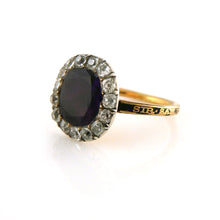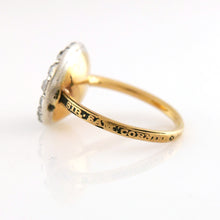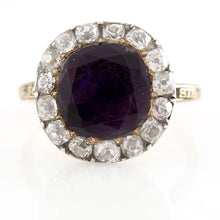Mourning Ring for Vice-Admiral Sir Samuel Cornish, 1770
- Regular price
- £5,500
- Sale price
- £5,500
- Regular price
-
- Unit price
- /per
Adding product to your cart
Finger size K
Amethyst, diamonds, gold and enamel. Bezel set with a faceted amethyst encircled by diamonds in a closed setting, the shank set with black enamel decoration around the inscription ‘Sir Sam. Cornish … 30 Oct 1770 AE 56’.
Sir Samuel Cornish is remembered for the Capture of Manila in 1762 during the Seven Years War - the conflict that found Britain competing with France and her allies around the globe. For nearly 200 years Manila had been at the centre of the imperial Spain’s galleon trade with Acapulco, trading Mexican silver for Chinese silk, porcelain and spices. After Spain allied herself with France in 1762, the British government approved plans to attack Havana and Manila.
Read more
Samuel Cornish was appointed to the command of the naval forces bound for Manila comprising 12 ships-of-the-line, 3 frigates and 4 store ships, with his flag in HMS Norfolk. Brigadier-General William Draper commanded land forces of 6,839 soldiers, sailors and marines. By posting a frigate in the Strait of Malacca, Cornish ensured that no news of the impending strike reached Manila prior to the fleet's arrival on 23 September 1762. The city walls were breached on 5 October and on the following day the place was taken by storm. Draper did his utmost to put a stop to the rape and plunder of the town, and with Cornish agreed to accept a ransom of 4 million dollars from the Spanish acting Governor-General Archbishop Manuel Rojo del Rio y Vieyra.
The British occupation of Manila lasted 18 months until the city was returned to Spain under the 1763 Treaty of Paris. During their time in the Philippines, the British found themselves confined to Manila and Cavite, but were rewarded with the capture of the treasure ships Filipina and Santísima Trinidad. These captures made Draper and Cornish wealthy men to the extent that they could retire on the prize money. Both were thanked in Parliament, and Cornish received a Baronetcy.
Sir Samuel Cornish (c1715-1770) was believed at one time to have risen from modest origins, and to have served his apprenticeship on a collier before being appointed to an East Indiaman, but it has been suggested these details relate to his father. Cornish is known to have entered the navy as a volunteer ‘per order’ in 1728. He was commissioned lieutenant in the Litchfield on 12 November 1739, and on 11 November 1740 he moved, with Captain Charles Knowles, to HMS Weymouth, in which he served in the ill-conducted combined operation at Cartagena during March and April 1741. On his return to England he was appointed to command the bomb-ketch Mortar; and on 12 March 1742 he was posted flag captain of the old HMS Namur, flagship of Admiral Matthews in the Mediterranean. In 1742 Cornish was appointed to command the Guernsey (50); and continued in her until the end of the ‘War of Jenkin’s Ear’, doing occasional good service in the destruction of Spanish privateers.

During the war of the Austrian Succession, he was present at the Battle of Toulon which saw the British lose control of the waters around Italy and Spain take the offensive against Savoy. Matthews was dismissed from the navy along with seven captains for lacking offensive spirit. Cornish’s part occasioned no comment, which must be considered an achievement in the light of the number of careers destroyed. On 9 March 1749, as a 'gentleman well skilled in mathematicks and natural knowledge', Cornish was elected to the Royal Society. In 1755 he commissioned HMS Stirling Castle for service in the channel, and in 1758 he was transferred to the Union (90 guns), and was ordered by Lord Anson to wear a distinguishing pennant.
On 14 February 1759 Cornish was promoted Rear-Admiral of the White, and sent out to the East Indies with a small squadron to reinforce Vice-Admiral George Pocock, and undertook operations to clear the coast of Coromandel, which established his reputation as a commander able to co-operate effectively with the army. He succeeded to the command of the East Indies station in 1761, but became embroiled in a dispute with the East India Company over the plunder taken from the French at Pondicherry. Nevertheless his professional competence in combined operations won him the command of the Manila expedition.
Cornish returned to Europe with a comfortable income from prize money. In 1765 he purchased the manors of Sharnbrook, Tafte, and Temple Hills in Bedford. The Duke of Norfolk supported his election as MP for Shoreham, a seat he held from December 1765 until his death, and on 9 January 1766 he was created a baronet, taking his style as Sir Samuel Cornish of Sharnbrook. About this time he married Susan, daughter of James Gambier of Holborn and sister of Admiral James Gambier; they had no children. Cornish died on 30 October 1770, whereupon his title became extinct and his estate passed to his nephew, Samuel Pitchford, captain in the navy, who took the name Cornish.
















